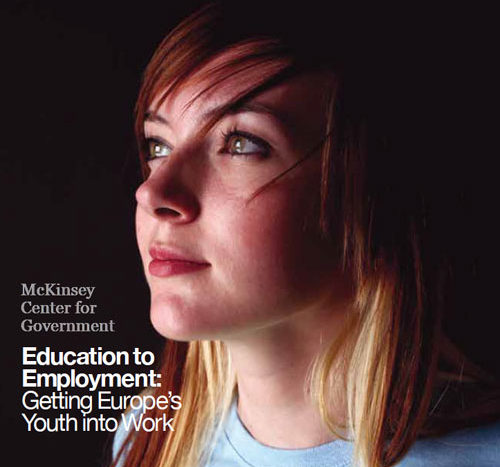1. Es suchen immer mehr Menschen in Europa nach Arbeit, doch Arbeitgeber finden immer schwerer Arbeitssuchende mit jenen Qualifikationen, die sie benötigen.
In Europa waren 74 Prozent der für den Report befragten Bildungsanbieter zuversichtlich, dass ihre Absolventen auf die Arbeit vorbereitet wurden – aber nur 38 Prozent der Jugendlichen und 35 Prozent der Arbeitgeber teilten diese Meinung. Ein deutlicher Hinweis, dass hier die Erwartungen und Bedürfnisse des anderen nicht verstanden werden.
2. Der Weg von der Ausbildung in den Job ist von zahlreichen Hürden geprägt.
Der Weg von der Ausbildung zur Beschäftigung (E2E, Education-to-emplayment) ist eine Strasse mit drei Kreuzungen: die Einschreibung in Hochschulbildung, den Aufbau der richtigen Fähigkeiten, und die Suche nach einem geeigneten Job. Das Problem ist, dass es in Europa an jeder diese Kreuzungen grosse Hürden gibt.
3. Die E2E-Struktur versagt besonders für junge Menschen und für kleine Unternehmen
Für diese Diagnose wurden in der Studie verschiedene prototypische Segmente von Berufsanwärtern analysiert. Sie wurden anhand zweier Faktoren bewertet: Wie viel Untersütztung sie auf ihrem Weg sie ins Berugsleben erhielten – und wie stark ihr Wunsch ausgeprägt war, die nötigen Skills für einen erfolgreichen Berufseinstieg zu erwerben.
Fazit:
Only one of our segments, the so-called high achievers, which represent 10 percent of the youth surveyed, achieves a good employment outcome. This group succeeded because the young people in it receive a strong education and good information; they also focus on finding opportunities to build job skills. Another two segments, representing 11 percent of youths surveyed—what we call “coasters” and “meanderers”—receive strong support but are less motivated and end up only moderately satisfied with their job outcomes. The remaining four segments (79 percent) are frustrated by a lack of support and unhappy at their prospects. They exhibit different responses to these circumstances, from fighting for every opportunity they can get (but rarely succeeding) to losing heart and leaving education at the first opportunity.
4. Es gibt bewährte – und wissenschaftlich evidente – Lösungen, um die Arbeitslosigkeit bei jungen Menschen zu senken
Dazu gehören:
Innovatives Design bei Ausbildungen und Finanzierung, um den Zugang leistbar und zugänglich zu machen
To reduce the cost of courses, one solution is to break up degree or vocational programs into individual modules that focus on building a particular set of skills while still counting toward a degree or formal qualification. Each of these modules would be short (weeks or months) and self-contained, enabling young people to combine and sequence them in the order that makes most sense for their career aspirations. This model also enables young people to take a break in their studies to work for a period, and then return and pick up where they left off.
Ein klarer Fokus auf die Verbesserung der Arbeitsbereitschaft
Young people, employers, and providers must change how they think about the E2E process. To make rational decisions, young people need to think more strategically about their futures. This is particularly important in Europe, where students often have to make life-defining decisions about their educational future by age 15—the time when many choose whether to pursue academic or vocational tracks. Students need more and better-quality information about different career paths, and need to be motivated to use it.
Eine Struktur/Institution, die die besten Interventionen filtert und skalierbar macht
Zwei Beispiele:
One way to improve this is to create a “system integrator” to gather and share information on the most salient metrics: job forecasts by profession, youth job-placement rates, employer satisfaction with the graduates of different programs, and so on. The system integrator would also identify and share examples of successful programs and work with employers and educators to create sectoral or regional solutions based on these. Technological solutions can also help to compensate for shortages of apprenticeships and other forms of short-term work placements. “Serious games” that mimic the workplace context, for example, are low-cost, low-risk ways for students to receive a personalized learning experience through repeated “play” of the game.
Quellen:


